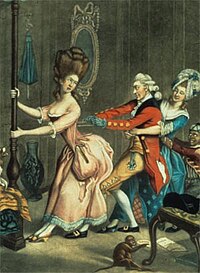
The Queen sits for an official photograph with Her Majesty's Body Guard of the Honorable Corps of Gentlemen at Arms. The Queen's ‘Nearest Guard’ commemorated the 500th anniversary of their founding with a parade and luncheon at St Jame's Palace.
Women's fashion
 .
.Women's clothing styles remained confining and cumbersome for most of the period. The hoop-skirts of the 1740s were left behind, but wide panniers (holding the skirts out at the side) came into style several times, and the aesthetic of a narrow inverted conical corseted torso above full skirts prevailed during most of the period.
In the 1780s, panniers finally disappeared, and bustle pads (bum-pads or hip-pads) were worn for a time.
By 1790, skirts were still somewhat full, but they were no longer obviously pushed out in any particular direction (though a slight bustle might still be worn). The "pouter-pigeon" front came into style (many layers of cloth pinned over the bodice), but in other respects women's fashions were starting to be simplified by influences from Englishwomen's country outdoors wear (thus the "redingote" was the French pronunciation of an English "riding coat"), and from neo-classicism. By 1795, waistlines were somewhat raised, preparing the way for the development of th e empire silhouette and unabashed neo-classicism of late 1790s fashions.
e empire silhouette and unabashed neo-classicism of late 1790s fashions.
Gainsborough's 1785 portrait of Mrs Hallett (right) captures the exact transition between the tight bodice and elbow-length, ruffled sleeves of the mid-18th century and the natural waist and long sleeves typical of the 1790s.
Portrait of Mr and Mrs William Hallett by Thomas Gainsborough, 1785.
In the 1780s, panniers finally disappeared, and bustle pads (bum-pads or hip-pads) were worn for a time.
By 1790, skirts were still somewhat full, but they were no longer obviously pushed out in any particular direction (though a slight bustle might still be worn). The "pouter-pigeon" front came into style (many layers of cloth pinned over the bodice), but in other respects women's fashions were starting to be simplified by influences from Englishwomen's country outdoors wear (thus the "redingote" was the French pronunciation of an English "riding coat"), and from neo-classicism. By 1795, waistlines were somewhat raised, preparing the way for the development of th
 e empire silhouette and unabashed neo-classicism of late 1790s fashions.
e empire silhouette and unabashed neo-classicism of late 1790s fashions.Gainsborough's 1785 portrait of Mrs Hallett (right) captures the exact transition between the tight bodice and elbow-length, ruffled sleeves of the mid-18th century and the natural waist and long sleeves typical of the 1790s.
Portrait of Mr and Mrs William Hallett by Thomas Gainsborough, 1785.
GownsThe usual fashion of the years 1750-1780 was a low-necked gown (usually called in French a robe), worn over a petticoat. If the bodice of the gown was open in front, the opening was filled in with a decorative stomacher, pinned to the gown over the laces or to the corset beneath.
Tight elbow-length sleeves were trimmed with frills or ruffles, and separate under-ruffles called engageantes of lace or fine linen were tacked to the smock or chemise sleeves. The neckline was trimmed with a fabric or lace ruffle, or a neckerchief called a fichu could be tucked into the low neckline.
The robe à la française featured back pleats hanging loosely from the neckline. A fitted lining or under-bodice held the front of the gown closely to the figure.
The robe à l'anglaise featured back pleats sewn in place to fit closely to the body, and then release into the skirt which would be draped in various ways.
Tight elbow-length sleeves were trimmed with frills or ruffles, and separate under-ruffles called engageantes of lace or fine linen were tacked to the smock or chemise sleeves. The neckline was trimmed with a fabric or lace ruffle, or a neckerchief called a fichu could be tucked into the low neckline.
The robe à la française featured back pleats hanging loosely from the neckline. A fitted lining or under-bodice held the front of the gown closely to the figure.
The robe à l'anglaise featured back pleats sewn in place to fit closely to the body, and then release into the skirt which would be draped in various ways.
Jackets and redingotes

Toward the 1770s, an informal alternative to the gown was a costume of a jacket and petticoat, based on working class fashion but executed in finer fabrics with a tighter fit.
The Brunswick gown was two-piece costume of German origin consisting of a hip-length jacket with "split sleeves" (flounced elbow-length sleeves and long, tight lower sleeves) and a hood, worn with a matching petticoat. It was popular for traveling.
The caraco was a jacket-like bodice worn with a petticoat, with elbow-length sleeves. By the 1790s, caracos had full-length, tight sleeves.
As in previous periods, the traditional riding habit consisted of a tailored jacket like a man's coat, worn with a high-necked shirt, a waistcoat, a petticoat, and a hat. Alternatively, the jacket and a false waistcoat-front might be a made as a single garment, and later in the period a simpler riding jacket and petticoat (without waistcoat) could be worn.
Another alternative to the traditional habit was a coat-dress call a Joseph or riding coat (borrowed in French as redingote), usually of unadorned or simply trimmed woolen fabric, with full-length, tight sleeves and a broad collar with lapels or revers. The redingote was later worn as an overcoat with the light-weight chemise dress.

0 comments :
Post a Comment
Click to see the code!
To insert emoticon you must added at least one space before the code.